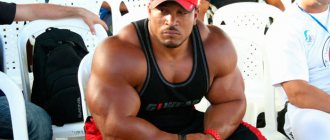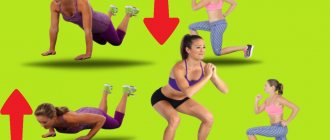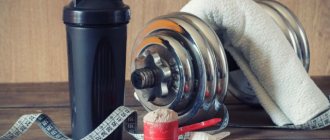A successful result in bodybuilding consists of three components - a balanced diet, a training program and regularity of exercise. You will have to work on nutrition and discipline on your own, but training is easier - not knowing where to start, it is suggested to work on a three-day split program. There are several proven training plans that are suitable for most men, so the novice athlete just has to choose the right one.
What is a three-day split and what are its benefits?
A split is a workout during which two muscle groups are loaded. This could be the chest and back, shoulders and legs, biceps and triceps. This approach has several advantages compared to working on one muscle group in one session:
- rapid progress;
- uniform workout of the whole body during the training week;
- adequate load, after which you do not need to recover for a long time;
- a large selection of exercises to emphasize the work of lagging muscle groups.
On average, large muscles need about 72 hours to recover, small groups about 48 hours. A three-day split allows you to create a program in such a way that you stay in good shape all week, without going to the gym like torture. So, having worked his back and shoulders on Monday, a man on Wednesday and Friday focuses on other areas, while these muscles rest. Of course, this approach will not relieve novice athletes from sore throat or delayed-onset muscle pain syndrome, but it will noticeably reduce discomfort than with three workouts a day for the whole body at once. And for those who have already become toned, a three-day split will allow you to build muscle mass faster when you compare such a program with a training plan designed to work one muscle group in one day.
Important rules to lose fat, maintain muscle
Gaining muscle is difficult, but losing weight and getting ripped while maintaining muscle is even more difficult.
If you really want to achieve low fat levels, these rules are your personal bible.
Train for strength, not endurance
There is an old belief that it takes long repetitions of definition exercises to define your muscles and allow them to stand out. But this is absolutely false.
After all, when you stick to your nutrition plan, you maintain your muscles, which means you maintain your metabolic rate. If you lose muscle mass, you will also lose the ability to burn fat.
Lifting weights tells your body that it needs muscle to live a full life.
Endurance training tells your body that it doesn't need muscle - it can be burned to provide energy for training. This is of no use to you at all.
Lowering the working weights on the barbell and dumbbells (despite nutrition) activates the process of muscle loss. Strength training at a high level of intensity will strengthen every cell in your muscles. They will protect them, preserve them and, in some cases, even increase their size.
Power loads, that is, working with iron, also do not require so much time. You can achieve results by stimulating your muscles over multiple repetitions.
Prefer those exercises that are sure to work
The fastest way to burn calories in the gym, raise your metabolic rate, and maintain muscle mass is to target new muscle gains through exercise.
You will stimulate your muscles and get enough growth hormone and testosterone to increase your strength, anabolic hormone levels and muscle growth.
Challenging tasks also help you aim for heavier weights over time.
The most difficult exercises fall into the following categories. They will become the basis of your 6-week program in order to pump up:
- Press exercises
- Stretching
- Squats
- Deadlift
About ready-made training plans
Each person's body is unique, so you cannot completely rely on ready-made training programs. This is suitable for beginners, but as you gain experience you need to learn to listen to your own body. In order for classes using ready-made training plans to be effective, it is recommended to follow a number of rules.
- The training program needs to be changed every two months, otherwise progress decreases as the muscles get used to the same type of load. There are two options here - either change the program by adding new exercises, or simply add working weights.
- A ready-made plan is more of a support for those who don’t know where to start than the only true guide to working on your body. You can rely on it, but nothing prevents you from rebuilding the program according to your own needs and preferences.
- In bodybuilding, you can’t do without basic exercises. The program for beginners should have more base, as it contributes to the rapid growth of physical indicators.
- If any muscle group is lagging behind in development, it is possible to modify the split by adding exercises for this area twice a week. The main rule is that there should be at least 60 hours between training large muscles, that is, lagging groups can be loaded on Monday and Friday.
With the right approach, training 3 times a week will help you quickly feel the results and achieve success in bodybuilding. The program is designed to stimulate muscle hypertrophy, so it is not suitable for beginners who have come to the gym for the first time. Beginners should follow a different program in the first two months, when all muscle groups are consistently worked out in one workout, and then you can move on to a three-day split. This is explained by the fact that during the first 60 days the body becomes toned and “tunes” for further muscle hypertrophy.
Training and nutrition tips
We recommend drying your diet to make your body even leaner.
So how can you make your muscles sculpted and achieve results as quickly as possible?
- Protein is everything - protein is needed not only to rebuild muscles after a workout, but also to fight hunger and feel full for a long time. Remember to consume about 1.4 – 2 grams of protein for every kilogram of your weight every day.
- Eat high-quality, natural foods—try to avoid processed foods and fast foods, such as candy, soda, or any fast food. Not only are they high in calories, but their calories are completely empty. The energy from them is consumed quickly and it is difficult to burn fat with its help.
- Cook Your Own – Cooking your own menu at home is a great way to always have healthy, nutritious food on hand. Prepare a few dishes for the next day and free yourself from unnecessary hassle tomorrow.
- Learn proper exercise technique before adding weight to the bar. Although you may be impatient, hold your horses. Everything has its time, and technically correct execution of each exercise will protect you from injuries in the future.
- Progressive Overload - Once the exercises become easy for you, it's time to add weight. This process is known as "progressive overload." Over time, your muscles adapt to the load. Alternatively, you can simply add a little more weight each workout.
- Rest as you please - It used to be believed that a short period of rest led to better muscle growth. But in our time, scientists have found that this is not entirely true. Both short and long rest periods have their pros and cons, and you only need to choose the method that is convenient for you.
- Don't forget about active recovery - instead of just sitting and looking at your phone, keep moving. This type of rest does not slow down blood circulation and helps maintain body tone.
- Don't forget about sleep - to get the full benefits of your workouts, try to sleep at least 7-8 hours a night. This number is not accidental: firstly, your body’s anabolic processes are most active during sleep, and secondly, it is when there is a lack of sleep that testosterone levels begin to fall. In addition, lack of sleep makes you hungry, and this harms muscle definition.
Basic three-day complex for beginners
This plan lasts for two months. The goal is to increase overall endurance and muscle strength.
Monday:
- crunches on a bench or on the floor;
- hyperextension – to strengthen the lower back, buttocks, and core muscles;
- squats with a barbell or dumbbells - to strengthen the hips, buttocks, and stabilizer muscles;
- Bench chest press – strengthens and develops the pectorals, biceps and triceps;
- pulling a vertical block behind the head or on the chest – development of the lats and upper back;
- lying down pullover – load on the lats and chest.
All exercises are performed 10-15 times in 4 approaches. Between approaches, rest no more than one and a half minutes, between different exercises - as much as is needed for recovery. The weight of the barbell for squats and bench presses is from 20 kg. The weight of dumbbells used is from 5 kg each.
Wednesday:
- lifting straight or bent legs in support - for the lower back and abs;
- classic push-ups from the floor or on parallel bars - development of pectorals, triceps, deltas;
- pulling the upper block to the chest with a narrow grip - load on the chest, biceps and triceps;
- French press – to strengthen the triceps;
- curling arms with dumbbells or a barbell - developing biceps;
- raising your toes – strengthening your lower legs.
If you have some strength left, you can add lying dumbbell flyes to your plan - another effective exercise for the chest. The program can be varied with other basic exercises. For example, change the base every week, or add different abdominal exercises.
Friday:
- hyperextension;
- deadlift with a barbell - works the lower back, hips and buttocks, forearms and upper back;
- lunges with dumbbells or a barbell in a Smith machine - development of the hips, buttocks, stabilizer muscles;
- standing chest press (barbell or dumbbells) - perfectly works the front and middle deltoids, triceps and forearms,
- stretching with a barbell - for the back and shoulders;
- Side swings with dumbbells - for shoulders, upper back and biceps.
The main rule is to complete the session with an isolated load on the lagging muscle groups. This could be lateral swings or bicep curls, calf raises or triceps curls.
Each workout begins with a warm-up and ends with a cool-down to stretch the targeted muscles. The number of repetitions and approaches of all exercises in the basic complex is 3-4 sets of 10-15 times.
Rest between exercises
Split training (what it is and how much time you need to spend resting between approaches is discussed in the program) allows stressed muscles to recover and grow faster. When lifting heavy weights, the athlete does a small number of repetitions using fast-twitch muscle fibers.
They are the strongest in the muscle, but they get tired quickly and require a lot of time to recover. Therefore, you need to take longer breaks between sets to develop strength. Exercises with light weights engage slow-twitch muscle fibers, which are responsible for endurance. They recover much faster than strong fast muscles and do not require much rest time.
Time recommended by experts for muscle recovery:
| Number of repetitions | Duration of rest, min |
| 1-3 | 3-5 |
| 4-7 | 2-3 |
| 8-12 | 1-2 |
| More than 13 | 1 |
Don't miss the most popular article in the section: Morning exercises for those over 40, 50. Gymnastics exercises for weight loss, video lessons.
Three-day split #1
On Monday, the latissimus dorsi and pectoral muscles are worked according to the following program:
- deadlift with a barbell – weight from 30 kg, 3 sets of 10-12 times;
- lying chest press – from 20 kg, 4x8;
- dumbbell bench press – from 8 kg, 4x8-12;
- pull-ups – 4x15;
- lifting legs in support – 4x10.
Working weights are selected individually. On average, the weight of the barbell should be more than 30 kg, dumbbells - from 8. But the readiness of a particular muscle for such loads should be taken into account. Work on lagging groups can be done with less weight, the main thing is that the athlete can do at least 6 repetitions without excessive effort.
On Wednesday – load on the arm muscles. Since the biceps and triceps are small, the emphasis is not on the number of repetitions, but on the number of approaches, otherwise the targeted zones will become clogged very quickly. Sample plan:
- push-ups – 3x15;
- reverse grip pull-ups – 3x15;
- bench press with a narrow grip – 30 kg, 4x10;
- French press – 10 kg, 3x12;
- standing arm curls (dumbbells) – 4x12;
- curls with a hammer grip - 12 kg per hand, 4x10;
- wrist flexion/extension with a barbell (sitting or standing) – 4x10.
On Friday, it is recommended to work out the lower body with the muscles of the shoulder girdle according to the following program:
- squats with weight – from 30 kg, 4x10;
- lunges in the Smith machine - 4x12 for each leg;
- leg press – from 20 kg, 4x15;
- seated bench press with dumbbells – from 10 kg, 3x12;
- standing barbell press – 3-15;
- broach – 3x10.
Each workout can be supplemented with 1-2 abdominal exercises, for example, hyperextension or crunches. Training your abs on a separate day is ineffective, as this area gets tired very quickly.
Can everyone make a relief?
Today everyone can make a sculpted body! But for this, some will have to not only sweat, but also resort to the use of pharmacological agents that are very dangerous to health. People who have metabolic problems associated with hormonal imbalance or gastrointestinal dysfunction, such as endomorphs, will not be able to achieve a sculpted body. People with such problems may not lose weight even with intensive training and diet; at least, the weight loss process will proceed extremely slowly.
Athletes who do not have problems of this type can count on ideal muscle shape, pronounced abs and a venous network visible through the skin. By the way, all this is easily achieved by ectomorphs - people with a type of constitution that is determined by the minimum percentage of fat in the body. There are also few muscle fibers in their body, but even small volumes on a naturally “dry” body look athletic.
How to properly increase loads
First you need to determine the working weight when performing an exercise for a specific muscle group. To do this, you should do a warm-up approach with light weight. Then select the weight of the apparatus, when performing the exercise with which the person will be able to do 8 repetitions and the last repetition will be done at the limit of strength, with muscle failure.
Beginning athletes need to do exercises with light weights during the first weeks, practicing the correct technique for performing them. Perfect technique will allow you to avoid injuries in the future and quickly build muscle mass.
The first set is done with weights that are 50% of the working weight and with a large number of repetitions (15-20), this approach will warm up the tissues and ligaments and saturate the muscles with blood.
After a few weeks of training, the athlete will be able to do not 8 repetitions with the working weight, but 12. Then the weight of the weight should be increased by 10% and continue training.











